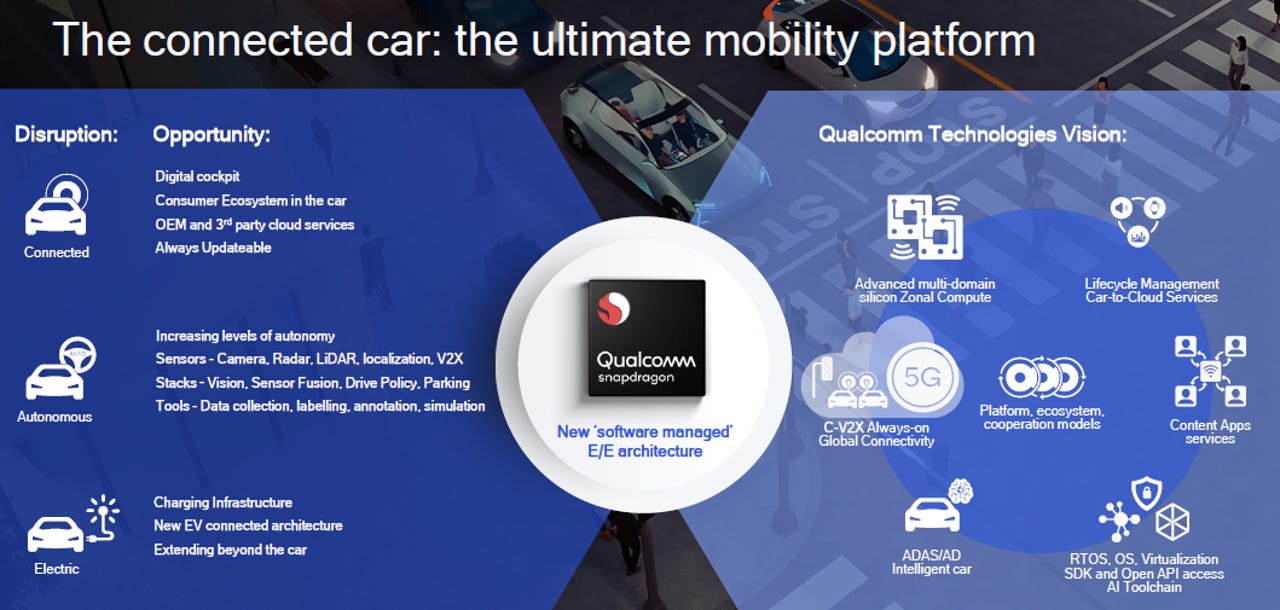Qualcomm aims to consolidate auto systems, expands GM, Amazon Alexa partnerships


Qualcomm on Tuesday outlined a broad strategy to advance its Snapdragon platform in the auto industry as it aims to expand in the cockpit as well as a bevy of subsystems.
The Qualcomm playbook for the automotive industry rhymes with its plans for IoT, artificial intelligence and compute. That strategy revolves around using 5G and the Internet of everything to consolidate compute platforms.
In an event dubbed Automotive Redefined, Qualcomm outlined a new software defined architecture called E/E (electronic/electrical) that aims to put its platforms in everything from the cockpit to autonomous driving to sensors to electric charging infrastructure. As automobiles become more connected via 5G enabled C-V2X technology, Qualcomm ultimately sees cars as the "ultimate mobility platform" with new experiences updated over the air.
Indeed, Qualcomm said it is extending its partnership with General Motors and plans to integrate Amazon's Alexa into its cockpit platform. Qualcomm said it will integrate Alexa Custom Assistant into its cockpit platform with customization with the Alexa Automotive Software Development Kit.
"The digital cockpit has become synonymous the ever-growing need for automakers to create a unique, differentiated and branded experience for their customer," said Nakul Duggal, senior vice president and general manager for Qualcomm's automotive unit.
Architecture matters
Qualcomm's approach to its auto architecture is similar to what has happened in the data center. In fact, many folks refer to an automobile as a data center on wheels. Qualcomm's architecture reflects how auto manufacturers want to move from a decentralized approach to sensors and functions to one that's based on services.
This auto stack would include a vehicle level, a multi-application and proximity level and a slice of the stack devoted to applications. There would also be a base that included node and sensors.
With this architecture, Qualcomm wants to use Snapdragon to play in everything from traffic services to telematics to autonomous driving, rear seat entertainment and the cockpit. All of these systems would be connected to the cloud and hyperscalers such as Amazon, Google and Microsoft.
Qualcomm reckons it already has more than 150 million vehicles with its technology embedded.
The company outlined the following:
- Its third generation automotive cockpit platform has been selected by more than 20 automakers with commercial production ramping in 2021.
- Qualcomm's Snapdragon platform for automotive cockpits will be available in the fourth quarter with a 5 nanometer design and the ability to handle multimedia, audio and video processing as well as cybersecurity, camera perception and system safety.
- The Snapdragon Rid Autonomous Stack aims to integrate deep learning, computer vision, vision perception, driver monitoring and other applications to integrate with smart city applications.
- Arriver, a driving policy and perception stack that creates a 360 model of the surrounding environment and combines various data and sensors.
- Systems on chips with Qualcomm's Kyro CPU and Adreno GPU as well as its AI Engine.
Auto competition intensifies
Qualcomm has big ambitions for the auto industry, but so do a bevy of rivals.
At CES 2021, a bevy of competitors outlined visions. For instance, Intel's Mobileye unit touted new processors for Lidar. Mobileye also is focused on autonomous driving as well as integrated maps, driving policies and safety and sensing systems.
Harman also outlined concepts that would personalize cockpits in vehicles going forward.
And Nvidia has its own autonomous vehicle platform called Drive that has gained traction.